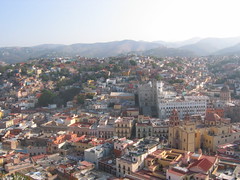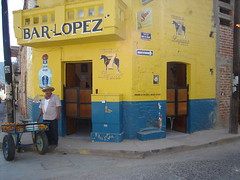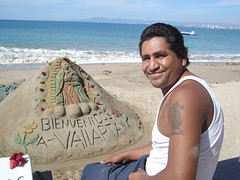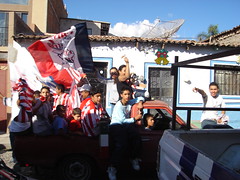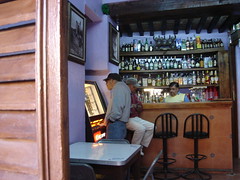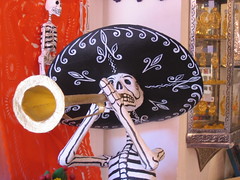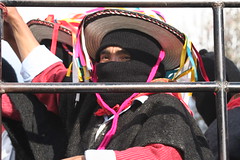Naturopathy focuses on diet, prevention
BY DAVID AGREN/The Herald Mexico
El Universal
September 02, 2006
Martha Herrera- Lasso, 20, used to faint every few months for inex plicable reasons. When she was 12, she consulted her family doctor, who diagnosed her with blood sugar problems. Later, she saw an endocrinologist and gynecologist. They prescribed costly medicines and hormones, but Herrera-Lasso continued feel ing lousy — and fainting at inop portune times.
Two years ago, taking the sug gestion of a friend and figuring she had nothing to lose, she tried some thing different and unconvention al: She visited a naturopath.
“I was pretty open-minded about it,” she recalled. “I had been with a lot of doctors ... but it hadn’t worked out.”
Within a week of following the naturopath’s advice, she noticed major improvements in her energy levels. Her blood sugar levels also seemed to steady. As the months passed, she stopped fainting, her digestion improved and she now leads a normal life as a theater and literature student at the National Autonomous University of Mexi co (UNAM).
Naturopathy, which worked well for Herrera-Lasso, departs from the traditional medical model of prescribing pharmaceuticals and simply treating symptoms.
It instead focuses on prevention, emphasizes nutrition and treats the patient holistically. It’s an increasingly accepted practice in the United States and Canada, but surprisingly, it’s virtually unknown in Mexico, where numerous curanderos and naturalistas ply their crafts and
tianguis vendors hawk miracle cures — some of dubious origins — for virtually every malady known.
“The naturopath studies the most perfect laboratory in the world, which is the human body,” said Bob Worthington, a naturo pathic doctor in Mexico City. “It’s basically getting back to nature.”
Worthington practices in a quiet home office in the leafy Colonia del Valle neighborhood, although he also sees clients during trips back to Riverside, Calif., where he resided prior to moving south in 2003, and El Salvador, his mother’s homeland.
PIONEERING
He mostly treats family members and friends along with people referred to him. In some ways, he’s a pioneer; the number of naturopaths working in Mexico is difficult to ascertain, but Worthington figured the number was extremely small.
Those who do practice in Mexico do so with few of the tools that their counterparts in Canada and the United States rely on. Quality nutritional supplements are generally in short supply; regulatory officials often prevent the impor tation of many vitamins and herbs. Many of the domestically-produced supplements inspire little confidence and Worthington said certain forms of many vitamins are classified as pharmaceuticals.
“Mexico tends to be very strict on their availability of natural sup plements,” he said, adding that product exaggerations are fairly common.
“In the United States, you can’t say anything about herbs that help. Here, the claims are just wild.”
Worthington keeps claims of naturopathy’s virtues to a minimum — even though he’s personally experienced impressive re sults. (He finally brought his own weight problem under control by figuring out the ideal diet and addressing the underlying problems.) He also said he would seek out a regular medical doctor in many situations.
“If I get run over by a truck, please don’t bring me an herb,” he said, laughingly. “Allopathic medicine is fantastic when it comes to trauma.”
Naturopathy has its critics, though, who charge that science and studies to back up claims are generally lacking. Mainstream medical doctors have been attacking naturopathy for decades — often branding practitioners as quacks. Some naturopaths use unconventional treatments like cleanses — traditional doctors say the body is self-cleansing and doesn’t really need an assist — and heavy doses of nutritional supplements.
Naturopathic education also varies. Some naturopathic medical schools offer curriculum similar to conventional medical schools, but teach more classes in nutrition and botanical medicine. (Medical students in some universities graduate without taking even a single nutrition course.)Graduates of these naturopathic medical schools — there are six in the United States and Canada — form professional associations and are licensed in certain jurisdictions. They are often allowed to prescribe some pharmaceuticals and perform minor surgeries.
Other schools, like the one Bob Worthington graduated from, also provide comprehensive programs, but don’t mirror normal medical education and teach a variety of disciplines, including herbalism and homeopathy.
SEEKING ALTERNATIVES
Despite the naysayers, many people disenchanted with mainstream medicine seek out a naturopathic approach and find it can sometimes work wonders — even in Mexico, where supplements are lacking.
Worthington makes up for a lack of tools by taking a different approach, but conceded it was difficult practicing upon his arrival in Mexico City.
“I was kind of traumatized,” he said.
He now depends on a limited range of available supplements and dispenses nutritional advice — primarily, what foods should be avoided. Additionally, Worthing ton uses applied kinesiology (also known as muscle testing) to assess what his patients lack and should stay away from. The practice, which is scorned by critics as junk science, has fallen out of favor in some naturopathic circles.
MET WITH SKEPTICISM
Worthington, who worked as an electrical engineer in the power industry before switching careers, acknowledged the skepticism, saying, “(Applied kinesiology) is sort of like witchcraft to traditional medicine.”
Results, however, prompted Worthington to use applied kinesiology, even though he found it somewhat tricky to learn and fully understand. (Several underlying factors, which unskilled practitioners sometimes ignore, can skew results.)
He explained applied kinesiology this way, “(By) using a muscle of the body, (you can) determine what is beneficial and what is not. What is giving it energy and what takes away energy.”
Worthington often uncovers food intolerances — which aren’t food allergies — through applied kinesiology. He said many of his clients have problems after eating dietary staples like wheat, dairy, corn, soy and sugar. Other supposedly-healthy foods can also be troublesome. Carrots caused digestive distress for one client.
After using applied kinesiology on Herrera-Lasso, Worthington discovered that wheat, milk and sugar triggered unpleasant symptoms. He banished all three offending foods from her diet. He also recommended two dietary supplements: magnesium and digestive enzymes. Herrera-Lasso followed the ad vice — even though “it was really hard” — and discovered many pleasant surprises as a result.
“I lost a lot of weight ... in a good way and my energy levels were high,” she recalled. “I stopped fainting and started feeling really well.”
Herrera-Lasso still avoids wheat, dairy and sugar and said eating a bowl of cereal in the morning pretty much ruins the rest of her day. She occasionally indulges a piece of birthday cake, though. The results are fairly predictable.
“I sometimes do eat (a forbidden food) ... but I feel really bad af terwards,” she explained. “My body just rejects it so it’s really not worth it.”
BETTER EMOTIONAL HEALTH
Herrera-Lasso still drops by Worthington’s office for consultations, mainly to deal with emotional issues, which she said can trigger problems if left unresolved. Worthington uses applied kinesiology and a form of emotional acupuncture to assess and treat his clients. He considers addressing emotion al health issues as important as treating the physical ones.
“Although you can do wonderful things with nutrition and diet, there comes a point where people get better, but it doesn’t quite seem to be enough,” he said. “The emotional side is very important.”
Due to Herrera-Lasso’s success with a naturopathic approach, many of her friends and family members now use Worthington’s services. Her improved health has also taken a load off of their minds, she said.
“It’s good because I have control now and that makes everyone feel safer.”
